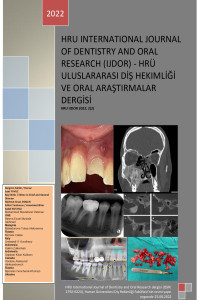APPLICATION OF FREE GINGIVAL GRAFT AROUND IMPLANT WITH INSUFFICIENT KERATINIZED MUCOUS
Implant, keratinized mucosa, free gingival graft
APPLICATION OF FREE GINGIVAL GRAFT AROUND IMPLANT WITH INSUFFICIENT KERATINIZED MUCOUS
Implant, keratinized mucosa, free gingival graft,
___
- 1) Thoma D. S., Muhlemann S., Jung R. E., Periodontology 2000, 2014; 66: 106–118.
- 2) Linkevicius T, Puisys A, Linkeviciene L, Peciuliene V, Schlee M. Crestal Bone Stability around Implants with Horizontally Matching Connection after Soft Tissue Thickening: A Prospective Clinical Trial. Clin Implant Dent Relat Res 2013; 9-11.
- 3) Monnet-Corti V, Santini A, Glise J, et al. Connective tissue graft for gingival reccession treatment: Assessment of the maximum graft dimensions at the palatal vault as a donor site. J Periodontol 2006; 77: 899-902.
- 4) 121) Reiser G, Bruno J, Mahan P, Larkin L. The suepithetial connective tissue graft palatal donor site: Anatomic considerations for surgeons. Int J Periodontics Restorative Dent 1996; 16: 130-137.
- 5) Bassetti RG, Stähli A, Bassetti MA, Sculean A. Soft tissue aug- mentation around osseointegrated and uncovered dental imp- lants: a systematic review.Clin Oral Investig 2017; 21(1): 53-70.
- 6) Thoma DS, Benić GI, Zwahlen M, Hämmerle CH, Jung RE. A systematic review assessing soft tissue augmentation techniqu- es.Clin Oral Implants Res. 2009;20(4): 146-65.
- 7) Hamurcu, N., Tunç , S., Binici, K., & Çetiner, D. Keratinize Mukoza Eksikliği Olan İmplant Bölgelerinin Otojen Yumuşak Doku Grefti İle Ogmentasyonu. KSU Medical Journal 2020; 15(3): 116-124.
- 8) NabersJM. Free gingival grafts. Periodontics, 1966; 4(5): 243- 245.
- 9) Wennström JL and Derks J. Is there a need for keratinized mu- cosa around implants to maintain health andtissue stability? ClinOral İmplants Res. 2012; 23: 136-146.
- 10) Buyuközdemir AS, Berker E, Akincibay H,Uysal S, Erman B,- Tezcan İ, Karabulut E.Necessity of keratinized tissues for dental implants: a clinical, immunologicaland radiographic study. Clin Implant Dent Relat Res 2015; 17(1): 1-12.
- 11) Linkevicius T, Apse P, Grybauskas S, Puisys A. Reaction of crestal bone around implants depending on mucosal tissue thickness. A 1-year prospective clinical study.Stomatol 2009; 11(3):83-91.
- 12) PuisysA, Linkevicius T. The influence of mucosal tissue thi- ckening on crestal bone stability aroundbonelevel implants. A prospective controlled clinical trial. ClinOral İmplants Res 2015; 26(2):123-129.
- 13) Lin GH, Chan HL, Wang HL. The significance of keratinized mucosa on implant health: a systematic review. J Periodontol 2013; 84(12): 1755-1767.
- 14) Hämmerle CHF,SchouS, Holmstrup P, Hjorting‐hansenE, Lang NP. Plaque‐induced marginal tissue reactions of osseointegra- ted oral implants: areview of the literature. Clin Oral Implants Res 1992; 3(4) :149-161.
- 15) Small PN, Tarnow DP. Gingival recession around implants: a 1-year longitudinal prospective study. InterJourOral Maxillofac Implant 2000; 15(4).
- Başlangıç: 2021
- Yayıncı: Harran Üniversitesi
SPLINT TREATMENT OF TEETH WITH EXTERNAL RESORPTION AFTER DENTAL TRAUMA: A CASE REPORT
THE RADIOLOGICAL EVALUATION OF IMPACTED THIRD MOLARS IN A GROUP OF TURKISH SUBPOPULATION
Ali ALTINDAĞ, Fatma YÜCE, Güldane MAĞAT
APPLICATION OF FREE GINGIVAL GRAFT AROUND IMPLANT WITH INSUFFICIENT KERATINIZED MUCOUS
Yusuf Ziya YÜNCÜ, Mehmet Emrah POLAT
DEBONDİNG İŞLEMİ SIRASINDA İLK HİSSEDİLEN AĞRININ VAS İLE DEĞERLENDİRİLMESİ
Tekli Dişeti Çekilmesinin Bağ Dokusu Destekli Modifiye Tünel Tekniği ile Kapatılması
PULPOTOMY TREATMENT OF PRİMARY TEETH
EVALUATION OF TEMPOROMANDIBULAR JOINT CBCT FINDINGS OF OSTEOARTHRITIS IN DIFFERENT PATIENT GROUPS
PERİODONTAL OLARAK ETKİLENMİŞ DİŞLERDE REİMPLANTASYON: GENEL BİR BAKIŞ
Mehmet Meriç ERSÖZ, Hasan HATİPOĞLU
Verda Gökçe ÇAKAR, Zelal SEYFİOĞLU POLAT, Azad ÇAKAR
ADENOİD YÜZLÜ ÇOCUKLARA ORTODONTİ VE ÇOCUK DİŞ HEKİMLİĞİ AÇISINDAN GÜNCEL BAKIŞ
